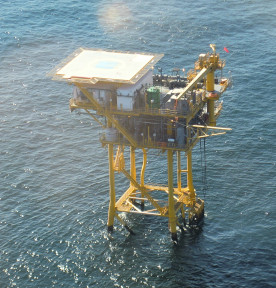Types of Fixed OCS Facilities (Fixed Platforms)
See also Drill Down Issue #5 for related information.
Fixed OCS Facilities, commonly referred to as "Fixed Platforms", can be constructed from several different structural designs. In this article, we'll look at the various designs associated with the fixed structures that are typically seen on the U.S. Outer Continental Shelf (Gulf of Mexico and off the coast of central California).
33 CFR 106 is applicable if the platform has 150 people onboard for 12 hours or more in each 24-hour period continuously for 30 days or more, or it produces greater than 100,000 barrels of oil per day, or produces greater than 200 million cubic feet of natural gas per day.
 Conventional
Conventional
Conventional fixed platforms used for the production of oil and/or natural gas are constructed atop steel jackets that are anchored with steel piles secured into the seabed. These platforms are strong and hold up well against environmental forces, but they are too costly for depths over 1,500 feet.
These platforms can be manned or unmanned. The owner/operator decides if the platform will be manned or not.
 Compliant Towers
Compliant Towers
Compliant towers have a smaller seabed footprint than the conventional fixed platform jackets and are flexible, which allows them to move with environmental forces. Compliant towers can consist of two types, a guy wire type and a freestanding tower.
A guy wired tower utilizes guy lines attached to the seafloor to keep the structure level, while the freestanding tower has no mooring other than the piles attached to the structure at the seafloor.
Compliant towers are used at water depths from 1,500 feet to 3,000 feet.
These platforms may or may not be manned.
 Bridged Platforms (or Complexes)
Bridged Platforms (or Complexes)
A bridged platform is a group of platforms (2 or more) attached to each other by a bridge (walkway that supports personnel transit and utilities between platforms). The platforms that are bridged can be conventional fixed platforms or compliant towers or a combination of the two, but they will normally be of one type (typically conventional fixed platforms).
The normal configuration is to have the accommodations on one of the platforms along with production equipment and the other platforms will only have production-related equipment.
Even though bridged, each platform is viewed as its own for the purposes for applying regulatory requirements and 33 CFR 106.

Junction Platforms
Junction platforms can be either a conventional fixed platform or a compliant tower. They are primarily used to combine multiple pipelines into one pipeline for transport oil crude oil or natural gas to refining facilities ashore.
In addition, they may also have equipment to boost the pressure going into the combined export pipeline.
These platforms may or may not be manned and may or may not meet the applicability of 33 CFR 106.